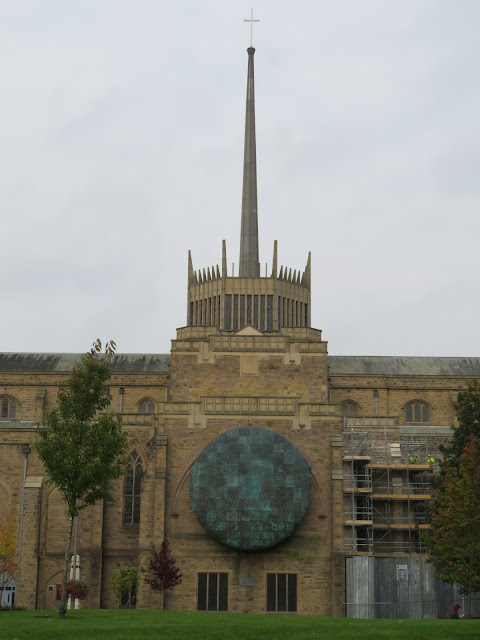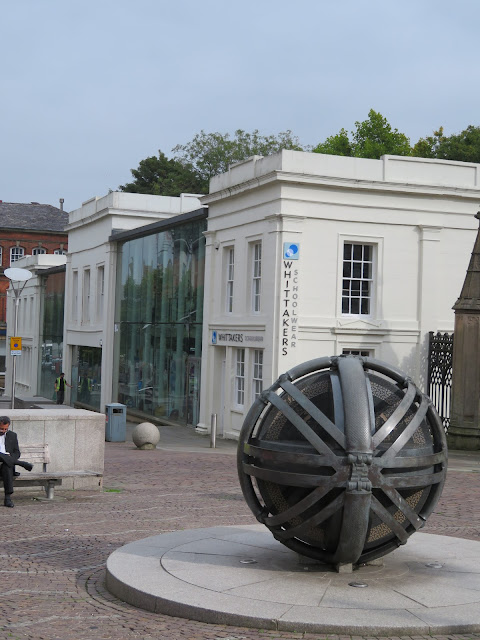It poured down in the night but was all quiet by about 0400. It got quite windy for a while and the mooring ropes were creaking.
It was very damp, but nice and calm by the time 0730 came about, and by the time we were under way the reflections in the water were still good.
A little further up the cut was this other shot of part of the Thirlmere Aqueduct. It is the longest in UK at just short of 96 miles long. Most of it is a D section 'cut and covered' concrete trough. There are no pumps in the line and the water flows down at around 4 mph. due to the fall of 20 inches every mile. The water takes a day from the reservoir to Manchester. The first water arrived in Manchester in 1894.
There are some great views of the rolling countryside along the way and it looks as though these ewes have been busy, or rather the rams have, due to their red painted backs.
We were soon at Johnson's Hillock Locks. We stopped for water and thought that a boat was coming up astern of us. Yippee, somebody to share the locks with. He pulled in to the moorings! Boo Ho.
The gates seem to be leaking quite badly and it made them harder than they might have been. However the weather was lovely and nice and warm when the sun shone. The flight is quite pleasant too, with plenty of folk to chat to.
Fortunately the major leaks seemed to be for the bottom gates, but I was glad that a put a small tarpaulin over the back deck just in case of a cascade into the engine hole. You can see Helen cocked across the lock here to avoid any leaks at the stern, just having to back to the cill to open the gates ahead.
No mention of the number of locks in either direction though!
At the foot of the Johnson's Hillock Locks is the entrance to the Lancaster Canal heading north. The canal was completed to near Wigan but the Ribble crossing via aqueduct never got built in its steed a tramway was built. IN 1810 the Leeds Liverpool Canal Company came to an arrangement with the Lancaster canal to avoid having to build a parallel canal. In 1851 the Leeds/Liverpool leased the canal tolls and section for an annula rent and this became permanent in 1864.
It is an unusual sight in the distance. Is the Preston England Temple of the Later Day Saints. It was started in 1994 and completed in 1998. It was called after Preston due to that being where the first Mormons arrived in the UK in 1837. The exterior is made of white granite and roof of zinc, and it is lit at night so it certainly stands out on the horizon.
BOtany Bay Mill was originally called the Canal Mill and was built in 1855. It was first closed in 1861 due to the cotton famine caused by the American Civil War. It was bought and struggled on until the 1950's when it closed as a mill. By 1968 a vehicle and truck company bought it but then in 1995 it opened as an antique and shopping destination after having nine million pounds spent on it.
This is one way to ensure that nobody jumps the queue for the lock!!
Cowling Mill looks like t=one of those Inca temples that has been recovered from jungle. It was built in 1900 but is now unloved. The 5.5 acre site is for sale for £2.5 million and the present owner will arrange for the demolition and clearance of the site at his expense.
There werre some lovely stretches with dappled sun through the trees.
This is the aqueduct over the River Douglas. I'm sure we will see more of this river in the future.
I saw this concrete pyramid in a field by the canal and was about 1m tall. I wondered if it was the base of an aerial but there were no others around or anchorage points evident. Anybody have any ideas.
A bit of autumn colour in the sun.
As we passed Haigh Hall Country Park, (pronounced Hay) we passed the Bssin Quay. The bridge was very low and it seems that it was opened in the 1780's. The Earles of Balcarres mined coal on the land and then found iron. It was boasted that Haigh Hall was built from iron, stone and timber from their own land.
The dash of blue alerted me to the presence of a kingfisher and it obliged by sitting just about long enough for me to photograph it. We will just have to see what the weather will be like tomorrow for the Wigan flight.






















































